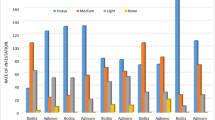Abstract
Although the prevalence of elevated childhood blood lead levels (BLLs) has been declining, there are still an estimated 500,000 children (1 to 5 years) with BLLs above the CDC’s reference value (≥ 5 μg/dL). The objective of this study was to evaluate the ecological association between soil lead (Pb) concentrations in greenspaces in Brooklyn, NY and elevated BLLs of children aged 1 to 5 years old. Soil samples (n = 1504) were collected from a wide variety of parks within 43 neighborhood tabulation areas (NTAs) located in Brooklyn, NY, analyzed with a portable XRF with a subset (n = 350), and also analyzed by ICP-MS. Lead concentrations were right skewed with a mean of 160.4 ppm and a median of 113.1 ppm. The Pb concentration range spanned three orders of magnitude with most samples (66.7%) ≥ 80 ppm and 6.7% of samples ≥ 400 ppm. Elevated BLL (≥ 5ug/dL) data on children 1 to 5 years were obtained from the New York City Department of Health and Mental Hygiene (2011–2015). Weighted median soil Pb concentrations were calculated for each NTA and stratified into quartiles. The overall median rate of children from 1 to 5 years old with BLLs ≥ 5 µg/dL was 28.6 per 1000; the median rate was highest (p = 0.070) in the fourth quartile (Pb concentrations ≥ 150 ppm) compared to the first quartile (Pb concentrations < 88 ppm), 37.2 vs. 28.3 per 1000, respectively. We then used multivariable linear regression to determine the ecological association between BLL rates and soil Pb concentrations. In the final stepwise multivariable regression model, controlling for known risk factors, there was a significant positive association between soil Pb concentrations and increased childhood BLL rates (beta = 0.0008; p = 0.004). Our findings suggest that there is an ecological association between high soil Pb levels and increased rates of elevated childhood BLLs.


Similar content being viewed by others
References
Abadin H, Ashizawa A, Llados F, Stevens Y-W (2007) Toxicological profile for lead
Bandeen-Roche K, Glass TA, Bolla KI, Todd AC, Schwartz BS (2009) The longitudinal association of cumulative lead dose with cognitive function in community-dwelling older adults. Epidemiology 20(6):831
Billick IH, Curran AS, Shier DR (1979) Analysis of pediatric blood lead levels in New York City for 1970–1976. Environ Health Perspect 31:183–190
Bradham KD, Nelson CM, Kelly J et al (2017) Relationship between total and bioaccessible lead on children’s blood lead levels in urban residential Philadelphia soils. Environ Sci Technol 51(17):10005–10011
Brooklyn Public Library (2020) Poison for profit. https://www.bklynlibrary.org/blog/2020/04/09/poison-for-profit Accessed 18 Oct 2021
Brunekreef B, Noy D, Biersteker K, Boleij J (1983) Blood lead levels of Dutch city children and their relationship to lead in the environment. J Air Pollut Control Assoc 33(9):872–876
California Office of Environmental Health Hazard Assessment (2009) Final report: revised california human health screening levels for lead and beryllium. https://oehha.ca.gov/risk/soils091709 Accessed 3 May 2021
Canadian Council of Ministers of the Environment (2021) Canadian soil quality guidelines for the protection of environmental and human health. https://ccme.ca/en/current-activities/canadian-environmental-quality-guidelines Accessed 22 Oct 2021
Canfield RL, Henderson CR Jr, Cory-Slechta DA, Cox C, Jusko TA, Lanphear BP (2003) Intellectual impairment in children with blood lead concentrations below 10 μg per deciliter. N Engl J Med 348(16):1517–1526
Cheng Z, Paltseva A, Li I et al (2015) Trace metal contamination in New York City garden soils 180(4/5):167–174
Chillrud SN, Bopp RF, Simpson HJ et al (1999) Twentieth century atmospheric metal fluxes into central park lake, New York City. Environ Sci Technol 33(5):657–662
Dietrich KN, Douglas RM, Succop PA, Berger OG, Bornschein RL (2001) Early exposure to lead and juvenile delinquency. Neurotoxicol Teratol 23(6):511–518
Dignam T, Kaufmann RB, LeStourgeon L, Brown MJ (2019) Control of lead sources in the United States, 1970–2017: public health progress and current challenges to eliminating lead exposure. J Public Health Manag Pract 25(1):S13
Dixon SL, Gaitens JM, Jacobs DE et al (2009) Exposure of US children to residential dust lead, 1999–2004: II. The contribution of lead-contaminated dust to children’s blood lead levels. EnvironHealth Perspect 117(3):468–474
Filippelli GM, Laidlaw MAS, Latimer JC, Raftis R (2005) Urban lead poisoning and medical geology: an unfinished story. GSA Today 15(1):4–11
Gustavsson N, Bølviken B, Severson RC, Smith DB (2001) Geochemical landscapes of the conterminous United States: New map presentations for 22 elements. US Department of the Interior, US Geological Survey
Hornung RW, Reed LD (1990) Estimation of average concentration in the presence of nondetectable values. Appl Occup Environ Hyg 5(1):46–51
Hunt A, Johnson DL (2012) Suspension and resuspension of dry soil indoors following track-in on footwear. Environ Geochem Health 34(3):355–363
Hunt A, Johnson D, Griffith D, Zitoon S (2012) Citywide distribution of lead and other element in soils and indoor dusts in Syracuse, NY. Appl Geochem 27(5):985–994
James G, Witten D, Hastie T, Tibshirani R (2013) An introduction to statistical learning, vol 112. Springer, New York
Kim DY, Staley F, Curtis G, Buchanan S (2002) Relation between housing age, housing value, and childhood blood lead levels in children in Jefferson County, Ky. Am J Public Health 92(5):769–772
Koller K, Brown T, Spurgeon A, Levy L (2004) Recent developments in low-level lead exposure and intellectual impairment in children. Environ Health Perspect 112:987–994
Laidlaw MA, Zahran S, Mielke HW, Taylor MP, Filippelli GM (2012) Re-suspension of lead contaminated urban soil as a dominant source of atmospheric lead in Birmingham, Chicago, Detroit and Pittsburgh, USA. Atmos Environ 49:302–310
Laidlaw MA, Filippelli GM, Sadler RC, Gonzales CR, Ball AS, Mielke HW (2016) Children’s blood lead seasonality in flint, Michigan (USA), and soil-sourced lead hazard risks. Int J Environ Res Public Health 13(4):358
Laidlaw MA, Filippelli GM, Brown S et al (2017) Case studies and evidence-based approaches to addressing urban soil lead contamination. Appl Geochem 83:14–30
Lanphear BP, Roghmann KJ (1997) Pathways of lead exposure in urban children. Environ Res 74(1):67–73
Lanphear BP, Succop P, Roda S, Henningsen G (2003) The effect of soil abatement on blood lead levels in children living near a former smelting and milling operation. Public Health Rep 118(2):83
Lanphear BP, Hornung R, Khoury J et al (2005) Low-level environmental lead exposure and children’s intellectual function: an international pooled analysis. Environ Health Perspect 113(7):894–899
Lewendon G, Kinra S, Nelder R, Cronin T (2001) Should children with developmental and behavioural problems be routinely screened for lead? Arch Dis Child 85(4):286–288
Li I, Cheng Z, Paltseva A, Morin T, Smith B, Shaw R (2016) Lead in New York city soils. International conference on landscape architecture to support city sustainable development. Springer, pp 62–79
Lidsky TI, Schneider JS (2003) Lead neurotoxicity in children: basic mechanisms and clinical correlates. Brain 126(1):5–19
Lynch EE, Meier HC (2020) The intersectional effect of poverty, home ownership, and racial/ethnic composition on mean childhood blood lead levels in Milwaukee County neighborhoods. PLoS ONE 15(6):e0234995
Mielke HW, Reagan PL (1998) Soil is an important pathway of human lead exposure. Environ Health Perspect 106(suppl 1):217–229
Mielke HW, Gonzales CR, Smith MK, Mielke PW (1999) The urban environment and children’s health: soils as an integrator of lead, zinc, and cadmium in New Orleans, Louisiana, USA. Environ Res 81(2):117–129
Mielke HW, Powell ET, Shah A, Gonzales CR, Mielke PW (2001) Multiple metal contamination from house paints: consequences of power sanding and paint scraping in New Orleans. Environ Health Perspect 109(9):973–978
Mielke HW, Laidlaw MA, Gonzales CR (2011) Estimation of leaded (Pb) gasoline’s continuing material and health impacts on 90 US urbanized areas. Environ Int 37(1):248–257
Mielke HW, Gonzales CR, Powell ET, Mielke PW Jr (2016) Spatiotemporal dynamic transformations of soil lead and children’s blood lead ten years after Hurricane Katrina: new grounds for primary prevention. Environ Int 94:567–575
Mielke HW, Gonzales CR, Powell ET et al (2019) The concurrent decline of soil lead and children’s blood lead in New Orleans. Proc Natl Acad Sci 116(44):22058–22064
Newell RG, Rogers K (2003) The US experience with the phasedown of lead in gasoline. Resources for the Future, Washington, DC
NYC Department of Health and Mental Hygiene (2019) Children under 6 years with elevated blood lead levels by NTA (preliminary data). http://a816-dohbesp.nyc.gov/IndicatorPublic/VisualizationData.aspx?id=2216,4466a0,14,Summarize Accessed 20 Jan 2021
Pavilonis B, Maroko A, Cheng Z (2020) Lead in New York City’s soils: Population growth, land use, and contamination. Int J Hyg Environ Health 229:113564
Schwarz K, Pickett ST, Lathrop RG, Weathers KC, Pouyat RV, Cadenasso ML (2012) The effects of the urban built environment on the spatial distribution of lead in residential soils. Environ Pollut 163:32–39
Shefa ST, Heroux P (2017) Both physiology and epidemiology support zero tolerable blood lead levels. Toxicol Lett 280:232–237
Stewart W, Schwartz BS, Davatzikos C et al (2006) Past adult lead exposure is linked to neurodegeneration measured by brain MRI. Neurology 66(10):1476–1484
Thermo Scientific NITON XL3t 500 Analyzer User’s Guide, vol Version 6.5
Thomas Rhiel (2013) Block by Block, Brooklyn’s past and present BKLYNR. vol 2021,
Tsoi M-F, Cheung C-L, Cheung TT, Cheung BMY (2016) Continual decrease in blood lead level in Americans: United States National Health Nutrition and examination survey 1999–2014. Am J Med 129(11):1213–1218
U.S. Census Bureau (2021) QuickFacts Kings County, New York. https://www.census.gov/quickfacts/kingscountynewyork Accessed 18 Oct 2021
U.S. Department of Health and Human Services (2020a) Childhood lead poisining prevention:blood lead levels in children. https://www.cdc.gov/nceh/lead/prevention/blood-lead-levels.htm. Accessed 21 Jan 2021
U.S. Department of Health and Human Services (2020b) Childhood lead poisoning prevention. https://www.cdc.gov/nceh/lead/prevention/sources/paint.htm#:~:text=Lead%2Dbased%20paints%20were%20banned,have%20some%20lead%2Dbased%20paint.&text=Approximately%2024%20million%20housing%20units,and%20lead%2Dcontaminated%20house%20dust. Accessed 21 Jan 2021
U.S. Environmental Protection Agency (2001) 40 CFR Part 745. Lead: Identification of dangerous levels of lead (final rule). Fed Regist 4(66):1206–1240
Walsh DC (1991) The history of waste landfnlling in New York City. Groundwater 29(4):591–630
Walsh DC, Chillrud SN, Simpson HJ, Bopp RF (2001) Refuse incinerator particulate emissions and combustion residues for New York City during the 20th century. Environ Sci Technol 35(12):2441–2447
Wendy Ruderman BL, Purcell D (2017) Toxic City Tainted Soil The Philadelphia Inquirer. Philadelphia
Xue J, Zartarian V, Moya J et al (2007) A meta-analysis of children’s hand-to-mouth frequency data for estimating nondietary ingestion exposure. Risk Anal 27(2):411–420
Zahran S, Laidlaw MA, McElmurry SP, Filippelli GM, Taylor M (2013a) Linking source and effect: resuspended soil lead, air lead, and children’s blood lead levels in Detroit, Michigan. Environ Sci Technol 47(6):2839–2845
Zahran S, Mielke HW, McElmurry SP, Filippelli GM, Laidlaw MA, Taylor MP (2013b) Determining the relative importance of soil sample locations to predict risk of child lead exposure. Environ Int 60:7–14
Acknowledgements
The authors would like to acknowledge the work of Ms. Johana Melendez Garcia, Ms. Emily Henderson, and Mr. Anselem Okorie for their help with sample collection and preparation.
Funding
Support for this project was provided by a PSC-CUNY Award [63782-00 51, 2020], jointly funded by The Professional Staff Congress and The City University of New York.
Author information
Authors and Affiliations
Corresponding author
Rights and permissions
About this article
Cite this article
Pavilonis, B., Cheng, Z., Johnson, G. et al. Lead, Soils, and Children: An Ecological Analysis of Lead Contamination in Parks and Elevated Blood Lead Levels in Brooklyn, New York. Arch Environ Contam Toxicol 82, 1–10 (2022). https://doi.org/10.1007/s00244-021-00902-7
Received:
Accepted:
Published:
Issue Date:
DOI: https://doi.org/10.1007/s00244-021-00902-7




